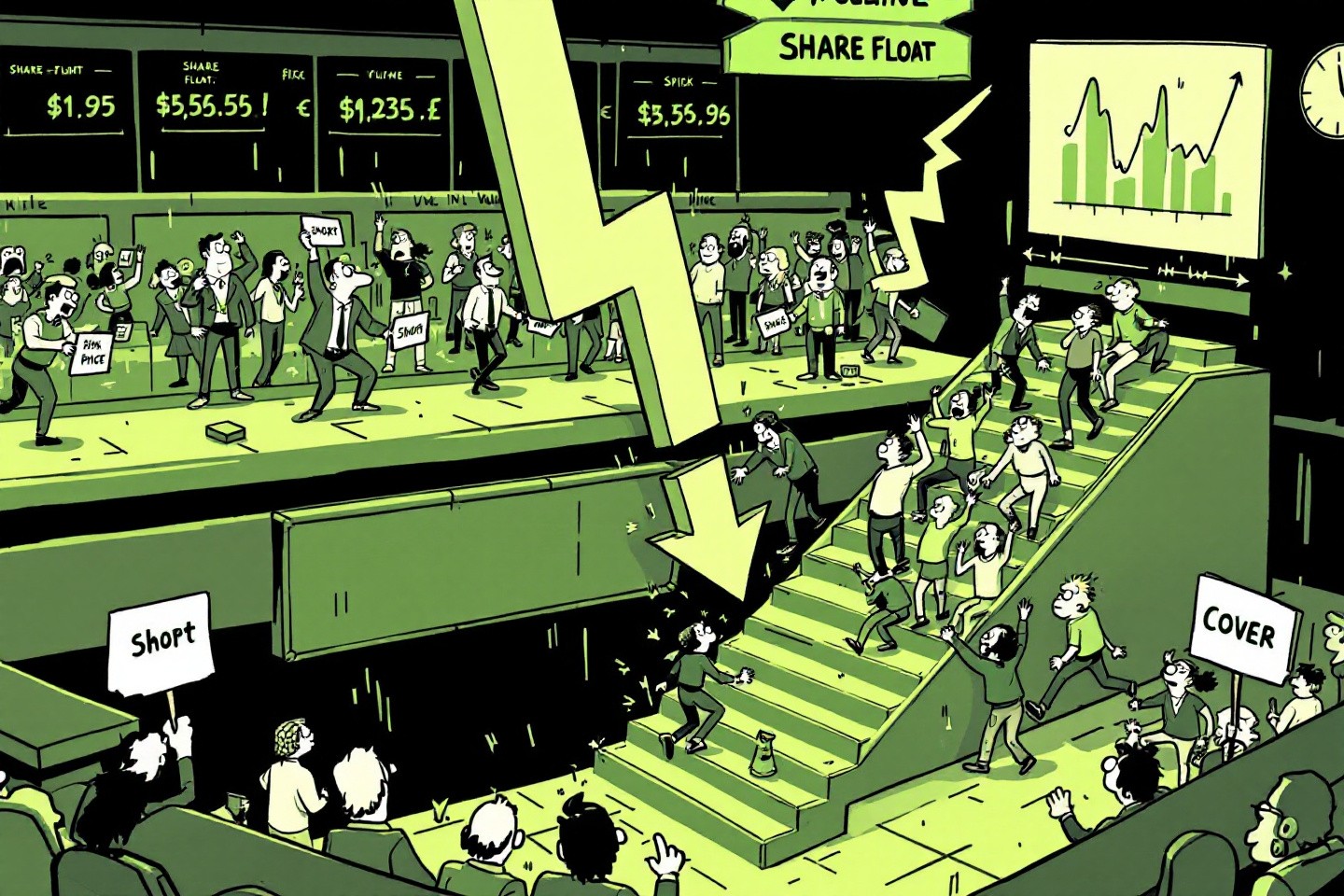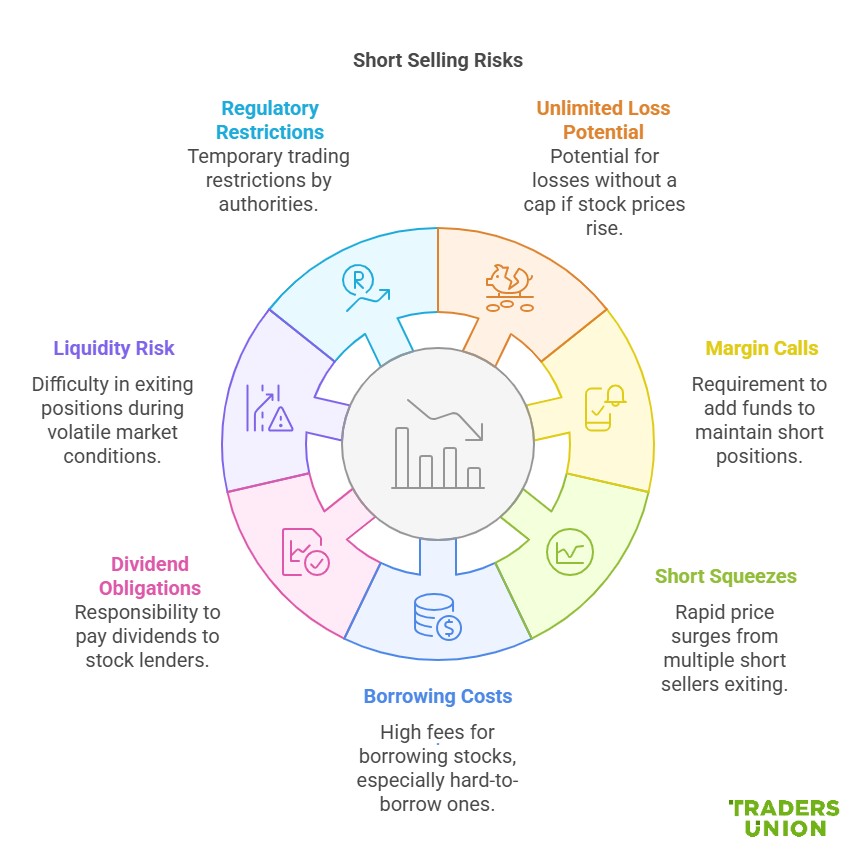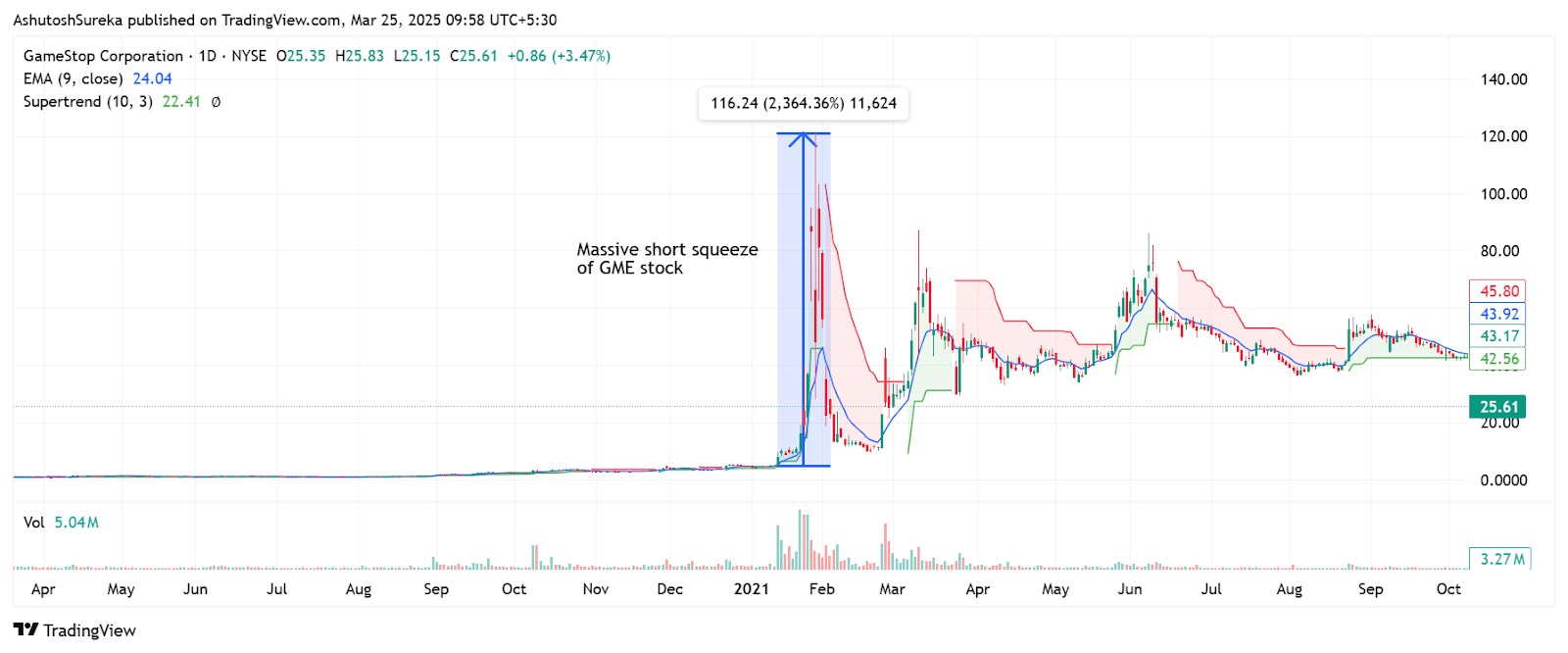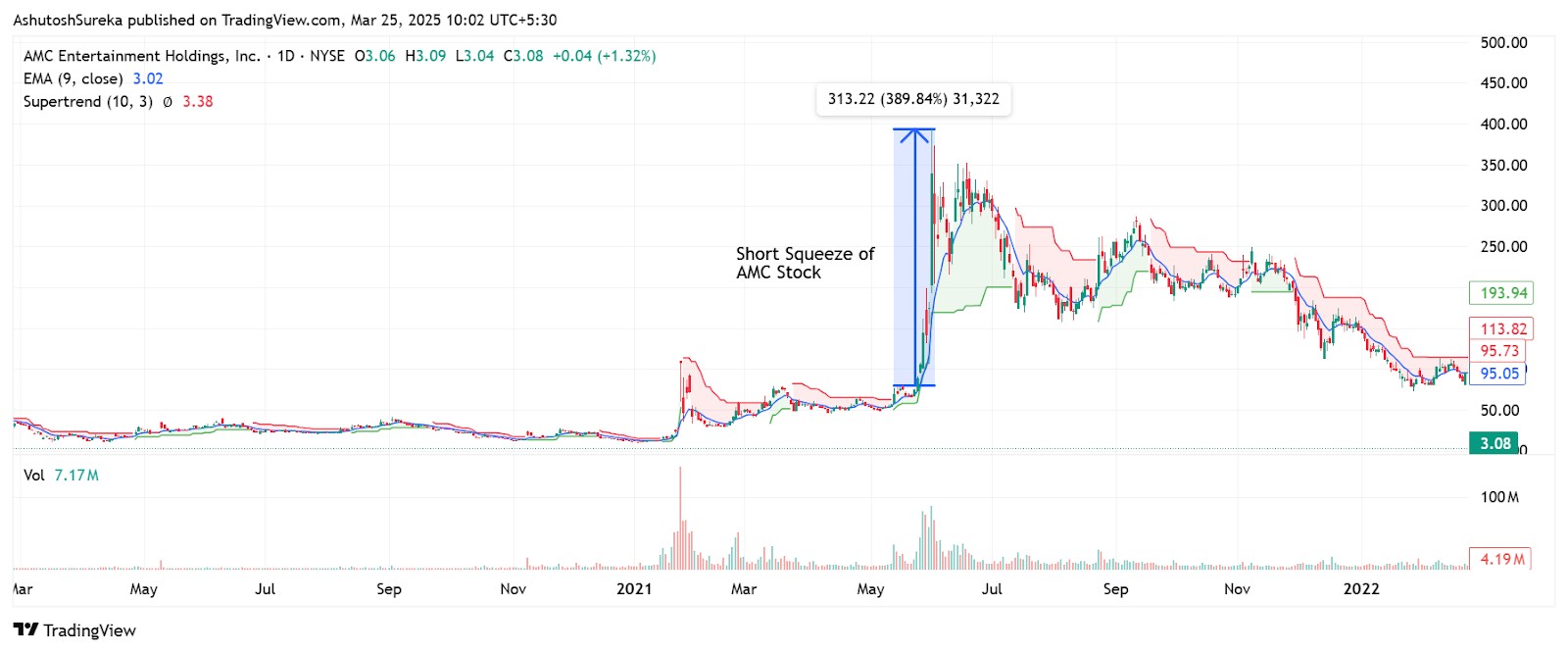What Really Causes a Short Squeeze In The Stock Market



Editorial Note: While we adhere to strict Editorial Integrity, this post may contain references to products from our partners. Here's an explanation for How We Make Money. None of the data and information on this webpage constitutes investment advice according to our Disclaimer.
A high short interest alone doesn’t guarantee a short squeeze. What really triggers one is a perfect storm: limited share float, rising volume, and too many traders trying to exit at once. When buying pressure hits a tightly crowded trade, panic sets in fast — every uptick forces more shorts to cover, accelerating the price surge. Watching short interest without tracking float and volume means you’re spotting the risk too late.
A high short interest alone doesn’t guarantee a stock will skyrocket. What really sparks a short squeeze is when the trade gets overcrowded and there simply aren’t enough shares for everyone to exit without taking a hit. It’s the perfect storm — tight float, thin volume, and too many traders piling onto the same bearish bet. When the momentum shifts, the panic isn’t slow. It’s sudden. Every uptick forces more short sellers to scramble and cover, and no one wants to be the last one stuck. If you’re only watching the short interest data, chances are, you’re already late.
Risk warning: All investments carry risk, including potential capital loss. Economic fluctuations and market changes affect returns, and 40-50% of investors underperform benchmarks. Diversification helps but does not eliminate risks. Invest wisely and consult professional financial advisors.
Understanding short selling
Short selling flips the usual investing idea on its head. Instead of buying low and selling high, you're trying to sell high first — then buy low later. It can lead to profits when stocks fall, but it also comes with serious risks that aren’t always obvious at first glance.

Definition and mechanics
Here’s how short selling works in plain terms:
You borrow shares of a stock from a broker and sell them at today’s price.
Later, you plan to buy the same number of shares back — hopefully at a lower price — and return them to the broker.
Your profit is the difference between the selling price and the buyback price.
Let’s say you short a stock at $100 and buy it back at $80 — you make $20 per share. But if the price rises instead, you’ll have to pay more to buy it back, which means you lose money.
Short selling is often used by traders who think a stock is overvalued or expect bad news to push the price down.
Risks associated with short selling

Short selling isn’t just risky — it can be dangerous if you’re not careful.
Unlimited loss potential. If the stock price rises instead of falls, your losses can keep growing with no cap — unlike buying a stock, where losses are limited to your investment.
Margin calls. Shorting requires a margin account, and if the trade goes against you, your broker may demand additional funds to maintain the position.
Short squeezes. When many short sellers try to exit at once, it can trigger a rapid price surge — forcing more covers and pushing prices even higher.
Borrowing costs. You have to pay to borrow the stock, and for hard-to-borrow shares, the fees can be steep, reducing your overall profit.
Dividend obligations. If the company pays a dividend while you're short, you’re responsible for paying that amount to the lender of the shares.
Liquidity risk. In volatile or low-volume stocks, exiting your short position can be difficult and costly, especially during sudden price moves.
Regulatory restrictions. Authorities may temporarily restrict short selling in turbulent markets, limiting your ability to trade or exit quickly.
What is short interest
Short interest helps you see how many people are betting that a stock will fall. It’s like a scoreboard showing how much pessimism is surrounding a company. But while it signals caution, it can also hint at big price moves — especially if those short bets start to unwind.
Definition of short interest
Short interest tells you how many shares of a stock are currently being shorted and haven’t been closed out yet.
A stock with high short interest has a lot of traders expecting the price to drop.
A low short interest means few people are betting against it.
It’s usually shown as a number or a percentage of the stock’s available shares (called the float).
If a company has 100 million shares in the float and 20 million are shorted, that’s 20% short interest — and that’s high enough to make some traders nervous about a possible short squeeze.
Measuring short interest
Looking at the number of shorted shares is just the beginning. There are a few key ways to measure how serious the short pressure really is:
Short interest ratio (SIR). This compares the shorted shares to the average number traded daily.
- If the SIR is 5, it would take five days of average trading volume to close out all short positions — a sign that any squeeze could be messy.
Days to cover. This is just another name for the short interest ratio.
- A high number means short sellers might struggle to exit quickly if the stock starts rising.
Float percentage. This shows what portion of the publicly traded shares are being shorted.
- Anything above 20% usually gets attention — and anything over 30% is seen as extremely risky.
High short interest implications and significance
When a lot of people are betting against a stock, it usually means something’s up. High short interest can be a red flag — or a setup for a surprise. For investors, it’s a signal worth watching, whether you're planning to short, buy, or just stay out of the way.
Indicators of high short interest
There are a few ways to tell when a stock has a lot of short pressure building behind the scenes:
Short interest as a percentage of float
- This shows how much of a stock’s publicly available shares are being shorted.
- If more than 20% of the float is shorted, that’s a sign of serious bearish bets. Anything over 30% is extreme.
Short interest ratio or days to cover
- This tells you how many days it would take for all short sellers to buy back their shares, based on average trading volume.
- A high number means it could be hard for short sellers to exit fast if the stock starts rising.
Sudden increases in short activity
- If the short interest jumps suddenly, it may mean that investors are reacting to bad news or spotting deeper issues.
By checking these signals together, you can get a clearer picture of how much pressure — and risk — is building under the surface.
Market sentiment behind high short interest
High short interest usually comes from skepticism, doubt, or fear. Investors short a stock when they believe it’s going to fall — whether because of weak earnings, too much debt, bad leadership, or something else.
It can signal that the market expects bad news ahead.
Sometimes it follows missed forecasts, scandals, or downturns in the industry.
Other times, it’s just a buildup of negative sentiment, even if the fundamentals aren’t that bad.
Understanding short squeezes
A short squeeze is one of those rare market events that can flip everything on its head. It kicks off when short sellers start scrambling to buy back shares, often all at once — and that buying frenzy sends the stock price soaring. When you see a stock jump 50% or more in a single day, there’s a good chance a short squeeze is behind it.
Definition and process
A short squeeze kicks off when a stock that a lot of people expected to fall starts rising instead. Since short sellers have to buy shares back eventually, a rising price means they’re losing money fast.
Here’s what it looks like:
A stock with lots of short interest starts climbing.
As losses pile up, short sellers start to panic and buy back shares to cut their losses.
That buying pushes the price even higher, which forces more shorts to cover.
Before long, there’s a frenzy of buying, and the stock can shoot up in a matter of hours or days.
It’s a snowball effect — the higher it goes, the more pressure there is to keep buying.
Triggers of a short squeeze
Short squeezes need a spark. That spark can come from just about anything that makes people rethink their negative outlook on the stock.
Some common triggers:
A company reports stronger-than-expected earnings, turning bears into believers.
News of a new product launch, merger, or partnership gives the stock fresh momentum.
A post on Reddit or a trending video can unleash a wave of retail buying.
A surprise investment from a big player can cause short sellers to rethink their bet — and exit fast.
Historical examples of short squeezes
Short squeezes don’t happen often — but when they do, they can flip the script on Wall Street. Some of the most famous squeezes in history weren’t just wild price swings — they were moments that exposed vulnerabilities in the market and rewrote the rules for both professionals and everyday traders.
GameStop
In early 2021, GameStop went from a fading mall retailer to the poster child of retail rebellion. Hedge funds were heavily shorting the stock, expecting it to keep sliding. But a group of retail traders on Reddit had a different idea.
GameStop had more shares shorted than were actually available to trade — a recipe for a massive squeeze.
As retail investors kept buying, the stock exploded from under $20 to more than $100.
Hedge funds that had shorted the stock were forced to buy back at huge losses, sending prices even higher.
The frenzy led to brokerage restrictions, political hearings, and global headlines.

Other notable short squeezes
AMC Entertainment
Right after GameStop, AMC became the next crowd favorite. Retail investors pushed the stock from just a few dollars to over $300, riding the momentum and turning theaters into a symbol of the fight against Wall Street.

Tesla
Tesla’s stock has been the source of multiple short squeezes over the years. As the company grew and its stock surged, short sellers lost billions. Elon Musk’s tweets and public jabs at shorts only added fuel to the fire.
Volkswagen
Back in 2008, Porsche revealed it had quietly bought a huge stake in Volkswagen. The news stunned the market and squeezed short sellers so hard that VW briefly became the most valuable company on Earth. It’s still considered one of the most brutal squeezes in history.
Identifying potential short squeeze opportunities
Catching a short squeeze before it takes off isn’t easy — but it’s possible. The key is knowing what to look for and when to act. By watching short interest levels and keeping an eye on what traders are talking about, you can start spotting the signs of a potential breakout.
Analyzing short interest data
To identify a stock that could squeeze, start by digging into the numbers.
Look at short interest as a percentage of float. If more than 20–30% of a stock’s available shares are shorted, there’s already tension building.
Check the short interest ratio (or days to cover). The higher it is, the longer it would take for shorts to buy back in — which can lead to a pile-up if the stock starts rising.
Notice any recent spikes in short interest. If more traders are betting against the stock but there’s a reason for optimism, that could flip the narrative quickly.
Monitoring market sentiment
Even a heavily shorted stock won’t squeeze unless something sparks a rush of buyers. That’s why it’s important to track sentiment across platforms and look for early signs of momentum.
Reddit threads, X (formerly Twitter), and YouTube videos can all fuel retail interest. If a stock starts trending, it may be on the verge of a breakout.
Look for unexpected good news — a solid earnings report, a new deal, or even a leadership change can swing sentiment quickly.
Pay attention to volume surges, especially if there’s no obvious reason. That’s often a sign that buyers are stepping in before the crowd.
Based on this detailed breakdown of short squeezes and trading dynamics, we’ve selected a list of brokers that can help you trade with the right tools and insights.
| Foundation year | Account min. | Demo | Deposit Fee | Withdrawal fee | Inactivity fee | Android | iOS | Regulation | TU overall score | Open an account | |
|---|---|---|---|---|---|---|---|---|---|---|---|
| 2007 | No | Yes | No | $25 for wire transfers out | $50 | Yes | Yes | FINRA, SIPC | 7.63 | Open an account Via eOption's secure website. |
|
| 2014 | No | No | No | No charge | No inactivity fees | Yes | Yes | FCA, FSCS, OSC, BCSC, ASC, MSC, IIROC, CIPF. | 7.39 | Open an account Via Wealthsimple's secure website. |
|
| 2015 | No | No | No | No charge up to a limit | Not specified | Yes | Yes | FCA, SEC, FINRA | 7.69 | Study review | |
| 1978 | No | Yes | No | No | No | Yes | Yes | FCA, ASIC, MAS, CFTC, NFA, CIRO | 7.45 | Open an account Your capital is at risk. |
|
| 2011 | No | No | No | $25 for wire transfers out | $25 | Yes | Yes | FINRA, SIPC, FinCEN | 7.33 | Study review |
Float and forced buying drive short squeezes — not short interest alone
One key thing beginners miss is how many shares are actually available to trade — not just how many are shorted. A stock might have a high short interest, but if there are plenty of shares floating around, the shorts can still exit without too much damage. But take a small-float stock with just 20% short interest? That’s where the trouble starts.
When daily volume increases and there’s not enough room for everyone to get out, you’ve got a pressure cooker. Add in a spike in options activity, and the whole thing can take off fast. At that point, you’re not betting on the stock — you’re betting on who’s going to blink first.
Another trigger that most people never think about? ETFs. If a highly shorted stock suddenly gets added to a fund, those passive buyers have no choice — they have to buy it, even at higher prices. Shorts get squeezed not because of hype, but because they’re now facing a wall of forced buying.
And most traders don’t even check for things like ETF rebalancing. That’s a mistake. If you want to catch a short squeeze early, look at where buying pressure is guaranteed, not just possible. Once forced buyers show up, the rest happens fast.
Conclusion
Short squeezes aren’t random — they build slowly, then break fast. It’s not just about how many people are betting against the stock, but whether they all get trapped at once. The biggest squeezes happen when there aren’t enough shares to go around and someone is forced to act. If you’re only jumping in when the stock is already flying, you’re chasing. The ones who catch it early are watching the setup, not the chart. That’s where the real edge is.
FAQs
Is 7% short interest high?
A 7% short interest is moderate and can suggest some bearish sentiment, but it's not considered extreme. It may indicate potential for a small squeeze if demand increases.
Is 50% short interest high?
Yes, a 50% short interest is extremely high and signals a strong bearish bet by traders. It also increases the chances of a powerful short squeeze if buying pressure rises.
What is the biggest short squeeze in history?
The GameStopshort squeeze in January 2021 is considered one of the biggest in history. It caused massive losses for hedge funds and drew global attention to retail trading power.
What is the best indicator for a short squeeze?
High short interest combined with low float and rising trading volume is a strong sign. A sudden spike in price and momentum can also point to a possible short squeeze setup.
Related Articles
Team that worked on the article
Andrey Mastykin is an experienced author, editor, and content strategist who has been with Traders Union since 2020. As an editor, he is meticulous about fact-checking and ensuring the accuracy of all information published on the Traders Union platform. Andrey focuses on educating readers about the potential rewards and risks involved in trading financial markets.
He firmly believes that passive investing is a more suitable strategy for most individuals. Andrey's conservative approach and focus on risk management resonate with many readers, making him a trusted source of financial information.
Also, Andrey is a member of the National Union of Journalists of Ukraine (membership card No. 4574, international certificate UKR4492).
Chinmay Soni is a financial analyst with more than 5 years of experience in working with stocks, Forex, derivatives, and other assets. As a founder of a boutique research firm and an active researcher, he covers various industries and fields, providing insights backed by statistical data. He is also an educator in the field of finance and technology.
As an author for Traders Union, he contributes his deep analytical insights on various topics, taking into account various aspects.
Mirjan Hipolito is a journalist and news editor at Traders Union. She is an expert crypto writer with five years of experience in the financial markets. Her specialties are daily market news, price predictions, and Initial Coin Offerings (ICO).
Risk management is a risk management model that involves controlling potential losses while maximizing profits. The main risk management tools are stop loss, take profit, calculation of position volume taking into account leverage and pip value.
A day trader is an individual who engages in buying and selling financial assets within the same trading day, seeking to profit from short-term price movements.
Short selling in trading involves selling an asset the trader doesn't own, anticipating its price will decrease, allowing them to repurchase it at a lower price to profit from the difference.
A margin call is a demand made by a broker or a financial institution to a trader or investor who is using margin (borrowed funds) to cover potential losses in a trading account. It occurs when the value of the securities or assets held in the account falls below a certain threshold, known as the maintenance margin or margin requirement, as specified by the broker.
Cryptocurrency is a type of digital or virtual currency that relies on cryptography for security. Unlike traditional currencies issued by governments (fiat currencies), cryptocurrencies operate on decentralized networks, typically based on blockchain technology.






























































































































